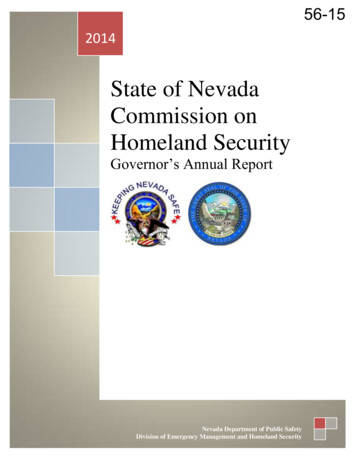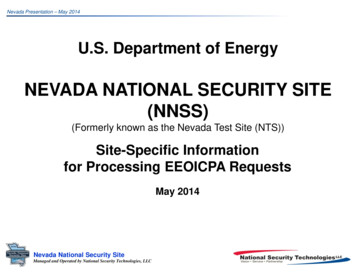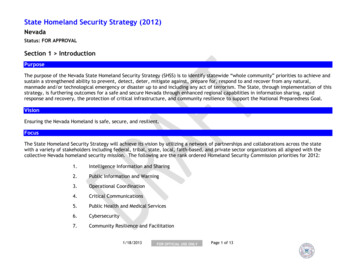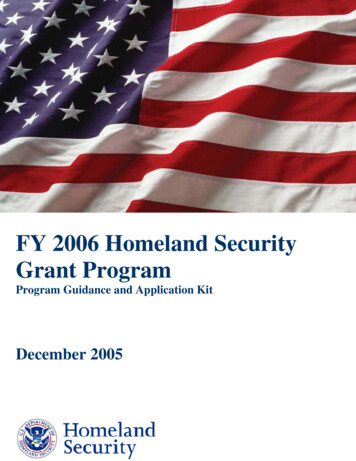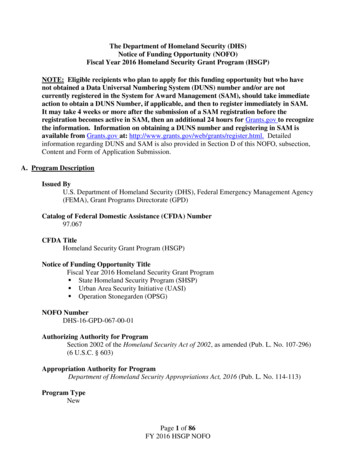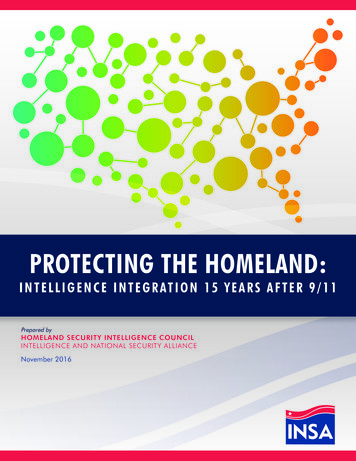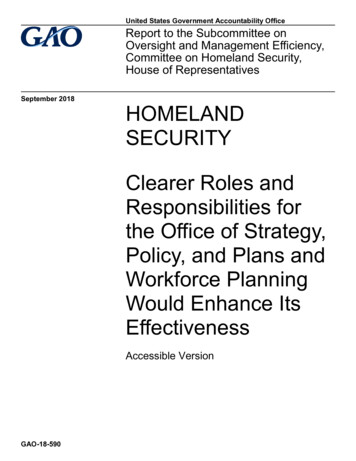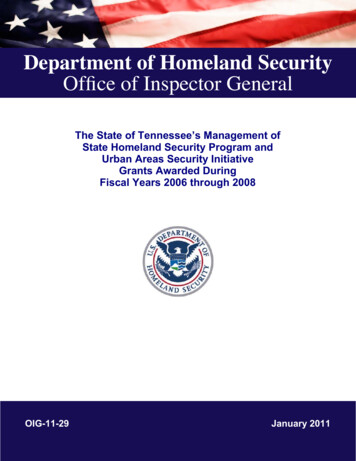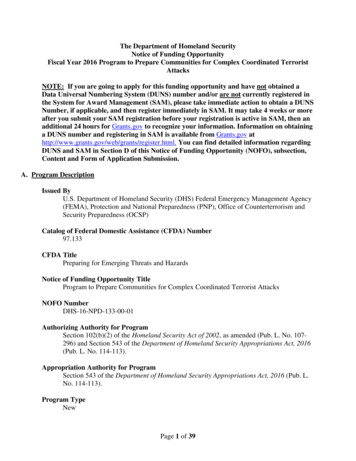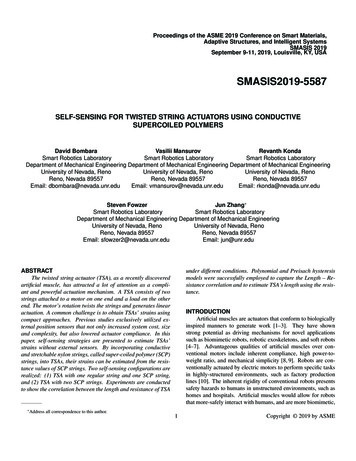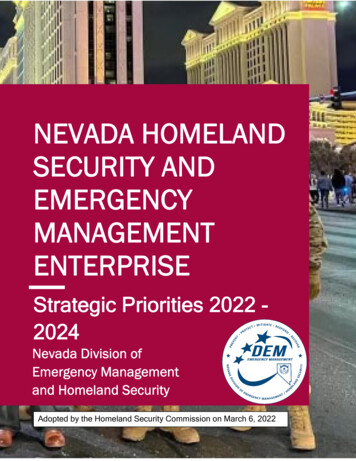
Transcription
NEVADA HOMELANDSECURITY ANDEMERGENCYMANAGEMENTENTERPRISEStrategic Priorities 2022 2024Nevada Division ofEmergency Managementand Homeland SecurityAdopted by the Homeland Security Commission on March 6, 20221
2Nevada Homeland Security and EmergencyManagement EnterpriseStrategic Priorities 2022 - 2024What is the “Enterprise?”Homeland Security and Emergency Management are broad fields that encompass manyother disciplines including law enforcement, fire service, emergency medical services, fusioncenters, cyber security professionals, education, election staff, public health preparedness,national guard, and many others. These fields come from the federal, state, tribal, local, andnon-profit levels within our state. It is important for us to recognize the diversity of thesegroups with the need to come together to share success to increase our resilience towardsany incident which may impact our citizens and visitors.SO, WHO IS IN CHARGE?As it is an enterprise, no one agency is in charge, rather the concept of meta-leadership iskey. Meta-leadership is the leading of other leaders. It takes all stakeholders to be engaged inthe process to increase our state’s resilience. The Homeland Security Commission is thehighest public body relating to these efforts. The Funding Committee assists the HomelandSecurity Commission in accomplishing their goals. The Nevada Resilience AdvisoryCommittee starts the process by assisting the Division of Emergency Management andHomeland Security in identification of needs to reduce our risks.Our risks are identified in several ways. The Threat and Hazard Identification RiskAssessment (THIRA) is the primary tool utilized. Public Health Preparedness conducts asimilar survey, known as the Jurisdictional Risk Assessment (JRA), to provide feedback.Other than these surveys, the feedback included in After Action Reports and ImprovementPlans (AAR/IP) from actual incidents, trainings, and exercises are key to testing our system.These reports are produced at every level of government within Nevada but fed back into theDivision for inclusion in our efforts to protect, prepare, mitigate, respond, and recover fromincidents.dem.nv.gov
3What grant sources are available for ourefforts?Funding for our efforts come from a multitude of sources. Federal funds come through eitherthe Division of Emergency Management and Homeland Security or the Division of Public andBehavioral Health. State funds come through smaller grants from the State EmergencyResponse Commission (SERC). Many local jurisdictions add to these grants with local fundsto ensure strategic programs continue to exist. Homeland Security Grant Program (HSGP)oState Homeland Security ProgramoUrban Area Security Initiative ProgramoNonprofit Security Grant ProgramEmergency Management Performance Grant (EMPG)DOE Agreement in Principle (AIP)Waste Isolation Pilot Plant (WIPP)Hazard Mitigation Grant ProgramCISA Cybersecurity Grant (pending release)Public Health Emergency Preparedness (PHEP)Hospital Preparedness Program (HPP)SERC Operations, Training, and ExerciseSERC United We StandThese programs have different inclusion criteria. The federal funds will come with varyingguidance each year on utilization purposes. It is important for Nevada to make determinationsof what efforts are so important to our homeland security and emergency managemententerprise that they must be maintained. Other programs may seek one time or short-termfunding to increase our capabilities. Not all these grant programs are under the purview of theHomeland Security Commission, but inclusion of them in this enterprise document isimportant to tell Nevada’s resilience story.dem.nv.gov
4Federal Mission Areas and Core CapabilitiesDepartment of Homeland Security and the Federal Emergency ManagementAgency break down the efforts to increase our resilience into five mission areas thatincorporate 32 core capabilities. Projects must tie into these capabilities to receive funding.The mission areas and their corresponding core capabilities are reflected below:Prevention PlanningPublic information and warningOperational coordinationIntelligence and information sharingInterdiction and disruptionScreening, search and detectionForensics and attributionProtection PlanningPublic information and WarningOperational coordinationIntelligence and Information SharingInterdiction and DisruptionScreening, Search, and DetectionAccess Control and Identity VerificationCybersecurityPhysical Protection MeasuresRisk Management for Protection Programs and ActivitiesSupply Chain Integrity and SecurityMitigation PlanningPublic Information and WarningOperational CoordinationCommunity ResilienceLong-Term Vulnerability ReductionRisk and Disaster Resilience AssessmentThreats and Hazards Identificationdem.nv.gov
5Response PlanningPublic Information and WarningOperational CoordinationInfrastructure SystemsCritical TransportationEnvironment Response/Health and SafetyFatality Management ServicesFire Management and SuppressionLogistics and Supply Chain ManagementMass Care ServicesMass Search and Rescue OperationsOn-Scene Security, Protection, and Law EnforcementOperational CommunicationsPublic Health, Healthcare, and Emergency Medical ServicesSituational AssessmentRecovery PlanningPublic Information and WarningOperational CoordinationInfrastructure SystemsEconomic RecoveryHealth and Social ServicesHousingNatural and Cultural Resourcesdem.nv.gov
6Strategic Programs (HSGP Funded)In 2018 the Homeland Security Commission developed a list entitled Strategic Capabilities tobe Maintained. This list was to be inclusive of programs which must be funded to maintain ourbase level of preparedness for homeland security and emergency management. This updated2022 document changes the name from strategic capabilities to strategic programs. Theefforts made by these programs is key for our continued efforts. If one of these programs fails,our resilience will suffer. Efforts must be made to annually ensure these programs are fundedthrough one of the available funding streams. This list should be evaluated annually to ensureevery program continues to answer the needs of our citizens and visitors.The strategic programs to be maintained include: Fusion Centerso Southern Nevada Counter Terrorism Centero Nevada Threat Analysis Center Citizen Corp ProgramsooooooSouthern Nevada Citizens Emergency Response Team (CERT)Douglas County CERTCarson City CERTWashoe County CERTElko County CERTStatewide Tribal CERT National Incident Management Systemo State of Nevada DEM National Incident Management Systemo Tribal National Incident Management System Chemical, Biological, Nuclear, Radioactive, and ExplosiveooooooTahoe-Douglas Bomb SquadElko Bomb SquadConsolidated Bomb Squad (Washoe, Reno, and Sparks)Las Vegas Bomb SquadLas Vegas ARMORUrban/Rural Frontier HAZMAT (Southern Nevada, Triad, and Quad) Operational Communicationso Statewide Interoperability Coordinator (SWIC) Public Information and Warningo Emergency Alerting System (consolidated among all jurisdictions led by DEM) Recoveryo Nevada Disaster Recovery Frameworko Nevada Preliminary Disaster Assessment (PDA) Tool (shared with State, Local& Tribal) PlanningooooPlanning efforts to maintain Continuity of OperationsPlanning efforts to maintain Mass FatalityPlanning efforts to maintain Community ResiliencePlanning efforts to maintain Metropolitan Medical Response System (UASI)dem.nv.gov
7Emerging IssuesEmerging issues are taken from current and forecasted needs from the THIRA, JRA, andAAR/IP. Highlighting them for funding via one time or short-term efforts to increase ourcapabilities and resilience. Applications for grant funding for these concerns should beconsidered competitive for the NRAC, HSC Funding Committee, and HSC to rank basedupon priority, degree of previous success, degree of perceived need, and completeness ofthe funding application.Emerging issues should not be seen as less important than the Strategic Programs listed.These are ones which may not be fully developed or require an annual investment to ensurecontinued success. Increasing Nevada’s resilience is tied to them but have factors differentthan our Strategic Programs to maintain which require funding to continue operations of theprogram.Nonprofit Security Grant ProgramFEMA provides a Nonprofit Security Grant Program where nonprofit faith-based organizationsapply for funding directly to them, but awards are managed by the Division. This grantprovides funding support for target hardening and other physical security enhancements andactivities to nonprofit organizations that are at high risk of terrorist attack. The intent is tointegrate nonprofit preparedness activities with broader state and local preparedness efforts.It is also designed to promote coordination and collaboration in emergency preparednessactivities among public and private community representatives, as well as state and localgovernment agencies.Cybersecurity Grant (pending release 2022)Cybersecurity and Infrastructure Security Agency (CISA) has announced release of a grant in2022 funded through the Infrastructure Investment and Jobs Act for the federal fiscal years of2022, 2023, 2024, and 2025. This grant is expected to be released in conjunction with theHomeland Security Grant Program notice of funding opportunities.Emergency Management Performance GrantGoalsThe Emergency Management Performance Grant (EMPG) is provided to the State, Tribal,and Local partners to increase our emergency management abilities. These abilities go handin hand with the homeland security mission as part of the enterprise. The performance periodon these grants is three years, as is the period for HSGP.dem.nv.gov
8The annual goals are predominantly determined by the THIRA. Participation by local andtribal partners in the THIRA process is required to receive any funding from this grant. FEMARegion IX and the Division negotiate on three annual priorities based upon the data. Regionalinfluences from California and Arizona may affect FEMA Region IX’s negotiation with Nevadaon the priorities but the process has been well received by FEMA and Division staff, whenbased upon the data provided from the THIRA. The State requires tribal and local governmentpartners to select at least one of the statewide priorities to focus their mission for the grantperiod while the Division must include all three priorities.Priorities for Years 2022, 2023, and 2024 Cyber SecurityFatality ManagementPublic Health and Social Services – Pandemic Response and Access and FunctionalNeedsPriorities for Years 2021, 2022, and 2023 Catastrophic Disaster HousingLogistics Distribution ManagementResilient CommunicationsHospital Preparedness ProgramThe Assistant Secretary for Preparedness and Response (ASPR) Hospital PreparednessProgram (HPP) is managed by the Public Health Preparedness Program located within theDivision of Pubic and Behavioral Health (DPBH). This program works with the state’s fourHealthcare Coalitions, local health authorities, DPBH, Nevada Hospital Association, and theDivision of Emergency Management to support diverse and often competitive healthcareorganizations with differing priorities and objectives to work together to save lives duringdisasters and emergencies that exceed the day-to-day capacity and capability of individualhealthcare and emergency response systems. The grant is generally a continual, 4-yearproject period and provides four capabilities for each awardee to strive toward:1.2.3.4.Foundation for Healthcare and Medical ReadinessHealthcare and Medical Response CoordinationContinuity of Healthcare Service DeliveryMedical SurgePublic Health Emergency Preparedness (PHEP)As with the Hospital Preparedness Program, The Centers for Disease Control and Prevention(CDC) Public Health Emergency Preparedness (PHEP) is managed by the Public Healthdem.nv.gov
9Preparedness Program located within the Division of Pubic and Behavioral Health (DPBH).This program works with Carson City Health and Human Services, Community HealthServices (part of DPBH), Southern Nevada Health District, Washoe County Health District,Nevada State Public Health Laboratory, and Nevada Tribal Emergency Coordinating Councilvia the Division of Emergency Management to support diverse and often competitive publichealth organizations with differing priorities and objectives to work together to save livesduring disasters and emergencies that exceed the day-to-day capacity and capability ofindividual public health emergency response systems.This grant supports six goals for Nevada to meet between 2019 and 2024:1) Nevada will have greater resiliency within communities to plan, prepare, and recoverfrom all-hazard events.2) Nevada will strengthen its ability to conduct all-hazard incident management bypreparation, planning, training, and exercising at all jurisdictional levels.3) Nevada will improve the ability to collect, share, and disseminate information timelyand accurately across all healthcare, public health partners, and the public.4) Nevada will strengthen access to and administration of medical and othercountermeasures for pharmaceutical and non-pharmaceutical interventions.5) Nevada will improve coordination regarding response to public health, medical surge,and mass care needs of affected communities impacted by an incident.6) Nevada will sustain and strengthen its abilities to surveil, detect, investigate, and testfor emerging threats and injuries to health of the public in all-hazard events.State Emergency Response Commission GrantsSERC Grants are managed by the State Emergency Response Commission with fundingcoming from federal partners to address hazardous materials (Chemical, Biological, Nuclear,Radioactive, and Explosive) issues by local jurisdictions and state agencies. TheCommission, located within the Department of Public Safety, State Fire Marshal Division, alsoprovides small grants to local governments and state agencies based upon revenuesreceived from the sale of United We Stand license plates. These goals normally follow thegoals established by the Homeland Security Commission.Department of Energy AIP and WIPPDepartment of Energy provides funding to the Division and other state agencies to prepareour enterprise for radiological events. Goals for these programs are determined by theEmergency Preparedness Working Group which incorporates the counties which receive thefunding.dem.nv.gov
10Hazard Mitigation Grant ProgramFEMA provides funding to the Division through the Hazard Mitigation Grant Program and theBuilding Resilient Infrastructure and Communities (BRIC) programs. These funds areallocated some as a base amount for the state and some as a varying amount tied to pastdisaster history. These programs seek submissions with program goals from the submitter tomitigate the risk of an incident.SummaryAs one can see, there are many efforts underway in Nevada to improve our resilience. Thisdocument will hopefully guide decision makers in their quest to fund programs while gainingan understanding of the efforts across the enterprise to increase our resilience. The adoptionof this by the Nevada Resilience Advisory Committee, Funding Committee of the HomelandSecurity Commission, and the Homeland Security Commission establishes the priorities forthe State when allocating Homeland Security and Emergency Management grant requestsunder the purview of the State Administrative Agency: the Division of EmergencyManagement and Homeland Security.dem.nv.gov
dem.nv.gov 6 Strategic Programs (HSGP Funded) In 2018 the Homeland Security Commission developed a list entitled Strategic Capabilities to be Maintained. This list was to be inclusive of programs which must be funded to maintain our base level of preparedness for homeland security and emergency management. This updated

